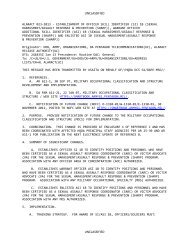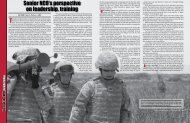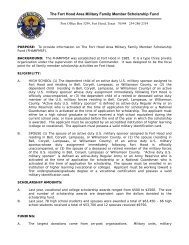Testing in a Joint Environment Roadmap - U.S. Army Operational ...
Testing in a Joint Environment Roadmap - U.S. Army Operational ...
Testing in a Joint Environment Roadmap - U.S. Army Operational ...
You also want an ePaper? Increase the reach of your titles
YUMPU automatically turns print PDFs into web optimized ePapers that Google loves.
For Official Use Only<br />
<strong>Test<strong>in</strong>g</strong> <strong>in</strong> a Jo<strong>in</strong>t <strong>Environment</strong> <strong>Roadmap</strong><br />
Appendix E – Glossary – Def<strong>in</strong>itions and Acronyms<br />
E.1 Def<strong>in</strong>itions<br />
− "Jo<strong>in</strong>t Mission <strong>Environment</strong>" – The operational context <strong>in</strong> which the capability be<strong>in</strong>g<br />
developed must perform.<br />
− "Jo<strong>in</strong>t Mission Infrastructure" – Collective term for the hardware/software – the<br />
comb<strong>in</strong>ation of representations of friendly and enemy forces and the geophysical<br />
environment, as well as the support<strong>in</strong>g <strong>in</strong>frastructure, required to generate the jo<strong>in</strong>t<br />
mission environment necessary for capability development and T&E.<br />
− "<strong>Test<strong>in</strong>g</strong>" and Test and Evaluation (T&E) – The term "test<strong>in</strong>g" (or test) is used for<br />
simplicity/brevity <strong>in</strong> some cases. Throughout the context of this report, the term<br />
"test<strong>in</strong>g", where applied, is synonymous with T&E.<br />
− "<strong>Test<strong>in</strong>g</strong> <strong>in</strong> a Jo<strong>in</strong>t <strong>Environment</strong>" – A more accurate description of the capability this<br />
roadmap will address than the title of the SPG paragraph, "Jo<strong>in</strong>t <strong>Test<strong>in</strong>g</strong> <strong>in</strong> Force<br />
Transformation". The report avoids the term "jo<strong>in</strong>t test<strong>in</strong>g" because this terms connotes<br />
test<strong>in</strong>g that requires participation of more than one Service, not always true, and is easily<br />
confused with the Jo<strong>in</strong>t Test and Evaluation (JT&E) program.<br />
− “Evolutionary Acquisition (EA)”– The preferred approach that fields an <strong>in</strong>itial<br />
operationally useful and supportable capability <strong>in</strong> as short a time as possible with the<br />
explicit <strong>in</strong>tent of deliver<strong>in</strong>g the ultimate capability <strong>in</strong> the future through one or more<br />
<strong>in</strong>crements. There are two approaches to evolutionary acquisition: 1) <strong>in</strong>cremental, and 2)<br />
spiral. With the <strong>in</strong>cremental approach, a desired capability and end state requirements<br />
are known at program <strong>in</strong>itiation, and these requirements are met over time by the<br />
development and field<strong>in</strong>g of <strong>in</strong>crements as technology maturity permits. With the spiral<br />
approach, a desired capability has been identified, but end state requirements are not<br />
entirely known at program <strong>in</strong>itiation. Each <strong>in</strong>crement of a spiral program provides the<br />
user with the best available capability at that time and then future requirements are<br />
developed and ref<strong>in</strong>ed over time based on demonstration, risk management, and<br />
cont<strong>in</strong>uous user feedback. Spiral development is the preferred approach to evolutionary<br />
acquisition.<br />
E.2 Acronyms<br />
Acronym<br />
ACASS<br />
Long Title<br />
Advanced Close Air Support System<br />
E-1<br />
For Official Use Only<br />
Appendix E






